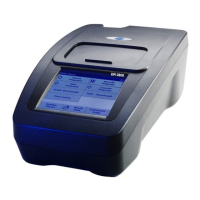89
Pour-Thru Cell
A.4 Using the Pour-Thru Cell
The Pour-Thru Cell is intended primarily for those methods that
specifically call for its use. These use liquid reagents, and are
typically denoted as ULR or Rapid Liquid methods. These methods
obtain maximum benefit from the Pour-Thru Cell by avoiding
turbidity from un-dissolved reagents, and provide the precision and
sensitivity required to determine very low concentrations. These
methods require no modification when the Pour-Thru Cell is used.
It is possible to use the Pour-Thru Cell for other methods, with a few
minor modifications. The cell requires a minimum volume of 25 mL
for proper flushing of any previous solution from the cell - so
methods that utilize a 10 mL sample volume cannot be used
directly. Tripling the sample and reagent volumes on these methods
(or use of 25 mL reagents and sample volumes) will provide
enough liquid to use the cell - however, an additional modification is
needed. Since the Pour-Thru Cell has a slightly shorter 1-inch
pathlength than the square cells for which most methods are
calibrated, it is necessary to multiply the results by a pathlength
factor of 0.95, or to perform a standard adjustment (section 5.4.5 on
page 36) on any method that utilizes 1-inch square cells. Always
confirm results with a standard solution, to make sure modifications
have been performed correctly.
Although the Pour-Thru cell can be used for the methods described
in Table 13, the cell must be thoroughly purged with distilled water
between individual samples.
The Pour-Thru Cell can also be used to run Nitrogen, Ammonia,
Nessler Method and TKN chemistries. Clean the cell by pouring a
few sodium thiosulfate pentahydrate crystals into the cell. Rinse out
the crystals with deionized water.
Important Note: In general, the Pour-Thru Cell cannot be used for
the methods described in Table 14.
Table 13 Methods that Require Additional Purging
Aluminum, Aluminon Chlorine Dioxide, LR Cobalt, PAN
Copper, Porphyrin Hardness, Calmagite Manganese, LR, PAN
Nickel, PAN Nitrate, MR Nitrate, HR
Table 14 Methods that Cannot be Used with the Pour-Thru Cell
Aluminum ECR Arsenic Barium Boron, Carmine
Cyanuric Acid Fluoride Formaldehyde Lead, LeadTrak
Mercury Nickel, Heptoxime Nitrite, HR PCB
Phenols Potassium Selenium Silver
Suspended Solids Sulfate TPH Volatile Acids
Zinc Surfactants, Anionic (Detergents)

